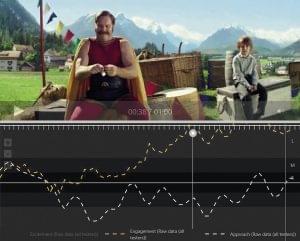FMCG and retail commercials from a neuromarketing perspective
Synetiq’s neuromarketing team measured more than 1,100 commercials in 2016 with their innovative method, and from these 500 were retail and FMCG ads. The company also kept market expectations and KPIs in mind, therefore they used questionnaires too in their work. Neuromarketing analyses people’s emotional reactions to commercials, with the help of physical reactions. Based on this psychological conclusions can be drawn. In the following you can read about some successful campaigns implemented in 2016.

Márton Czető
researcher
Synetiq

Réka Fruzsina Kis
senior insight consultant
Synetiq

 This Christmas Lidl decided to rely on current musical and visual trends in their communication activities. They opened the Christmas campaign with an Emily Roberts song and an unusual Santa Claus. Consumers really liked the ‘drop the base’ moments and jokes: they said the commercial was entertaining and memorable. It is very difficult to decide who to make the face of a brand. In 2016 SPAR perfectly chose and built their ambassadors, with its credible and likeable members the Fresh Guard team did a perfect job. Members of this team represent various product groups and each of them has its own story and image.
This Christmas Lidl decided to rely on current musical and visual trends in their communication activities. They opened the Christmas campaign with an Emily Roberts song and an unusual Santa Claus. Consumers really liked the ‘drop the base’ moments and jokes: they said the commercial was entertaining and memorable. It is very difficult to decide who to make the face of a brand. In 2016 SPAR perfectly chose and built their ambassadors, with its credible and likeable members the Fresh Guard team did a perfect job. Members of this team represent various product groups and each of them has its own story and image.

 ALDI’s anglers were able to cope with one of the biggest challenges. The simple story and dialogue showed how the typical characteristics of the retail sector can be left behind, while the focus is being kept on the retail chain. Nespresso’s commercial recreated the atmosphere of gangster movies, and thanks to the good story it managed to turn the product into the main star of the film instead of celebrated actor George Clooney. The commercial got the message through: Nespresso capsules are recycled. It must also be mentioned that the Hungarian-language explanation was unnecessary.
ALDI’s anglers were able to cope with one of the biggest challenges. The simple story and dialogue showed how the typical characteristics of the retail sector can be left behind, while the focus is being kept on the retail chain. Nespresso’s commercial recreated the atmosphere of gangster movies, and thanks to the good story it managed to turn the product into the main star of the film instead of celebrated actor George Clooney. The commercial got the message through: Nespresso capsules are recycled. It must also be mentioned that the Hungarian-language explanation was unnecessary.

 In 2016 Sió came out with several advertisements, from which the most original was the one that communicated the extra fibre content of Sió Friss fruit juices. These commercials presented very original – sometimes almost absurd – ideas for shaking up a box of fruit juice. They were not only memorable but also told the most important product characteristics. Milka’s commercials weren’t revolutionary new but they managed to involve viewers and fitted into the usual fairytale world of the brand. The story, the humour, the pleasant family atmosphere – there was something in each commercial that viewers liked.
In 2016 Sió came out with several advertisements, from which the most original was the one that communicated the extra fibre content of Sió Friss fruit juices. These commercials presented very original – sometimes almost absurd – ideas for shaking up a box of fruit juice. They were not only memorable but also told the most important product characteristics. Milka’s commercials weren’t revolutionary new but they managed to involve viewers and fitted into the usual fairytale world of the brand. The story, the humour, the pleasant family atmosphere – there was something in each commercial that viewers liked.
As a conclusion we can say that there is no recipe which guarantees success. Still, it is clear that those commercials were successful which dared to come up with something new. Companies which were even able to keep their existing and desired brand image in mind could also generate pleasant feelings towards their products in the 15-30 seconds of their commercials. And from this point on the rest of the success doesn’t depend on the commercials. //
Related news
(HU) A jövőnek kell dolgozni úgy, hogy ne vegyük el a fókuszt a jelenről
Sorry, this entry is only available in HU.
Read more >St. Hubertus’ new, captivating commercial tells the story of the power of friendship
The new St. Hubertus commercial has arrived, guaranteed to touch…
Read more >AI-generated ads can have a negative influence on consumer perception
According to recent NIQ research, AI-generated advertising may have a…
Read more >Related news
WHO: They urge a 50 percent price increase for tobacco, alcohol and sugary drinks
The World Health Organization (WHO) is calling for the prices…
Read more >Eurozone economic growth accelerated in June
The eurozone’s economic performance accelerated in June, according to the…
Read more >This is how drug prices are changing: the government introduced price restrictions
The Ministry of National Economy’s price restrictions on medicines came…
Read more >






